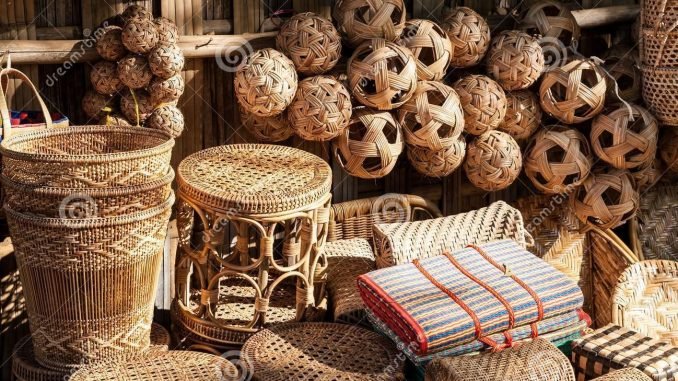
Cane (Calamus species) known in Myanmar as Kyein is found throughout the country in the moist forests of the plains and lower hills. Several species are erect, but the most useful kinds climb and scramble sometimes attaining a length of 400 feet.
Canes have some special qualities. They are strong, pliable and resilient, and are obtainable in great length with little taper. The outer silica layer of the flexible stem gives strength. It can be bleached with sulfur fumes while smoking and oiling can be affected to suit certain purposes. Thickness, length, and durability depend on the species.
Types of cane available:
Thin canes: Kyet-oo-Kyein, Kyein-ni, Kyein-byu-gale, Ye-Kyein, of one-eighth inch to one-half inch diameter with length up to fifty feet.
Thick canes: Yamata, Thaing-kyein, Kabaung-kyein, of one-half inch to two inches in diameter with length up to fifty feet.
Cane is widely used in furniture making industries where it is woven into seats and back-supports for chairs, and other articles like tabletops, etc. Cane furniture is very much in vogue nowadays and can be very expensive. Contact with foreign countries had opened the eyes of local producers of cane furniture to new designs and techniques so that a lot of cane furniture is now being made locally and exported to European countries.
Caneware is a popular cottage industry all over Myanmar and a number of popular items such as cradles, hats, walking sticks, lunch and breadbaskets, fruit trays and other receptacles are made here in all grades and specifications. More and fancier articles that were not seen before are now readily available in the market. Lampshades, handbags, attaché cases, big laundry baskets, office file holders are examples of the extensive use of the cane for both home and commercial use.
Two kinds of patterns are generally used when weaving seats and back-supports for chairs, and for tabletops. One is tightly woven to give lasting strength whereas the other pattern is ideal for chair seats as it is springier. In addition, the thick cane is used in innovative ways to take the place of wood in furniture design. They are used in natural cane color, or in glossy black.
With the trend in home furnishings turning towards natural materials, cane and rattan ware manufacture has also tried to meet the demand by turning up with more and more new items. Mirrors framed in woven cane, big cane frogs with the gaping mouth to hold anything you can think of, flower pot holders of intertwined thick cane are all decorative items in a modern home.